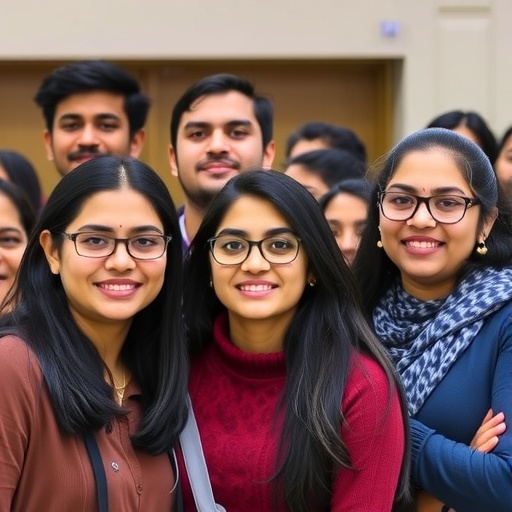In recent years, there has been a significant shift in the landscape of higher education, particularly regarding student diversity. A recent study conducted in India has shed light on the multifaceted factors influencing the prevalence of diverse student populations within higher education institutions. This data-driven case study by Jain, Haroon, and Ganeshan meticulously explores these dynamics, providing invaluable insights that could potentially reshape strategies for educational enrichment in India and beyond.
The importance of student diversity cannot be overstated. Diverse student bodies are known to foster richer discussions, stimulate critical thinking, and better prepare students for a globalized world. Accordingly, the research undertaken by Jain and colleagues captures the critical variables influencing diversity, aiming to bridge existing gaps and promote equitable access to education for all demographics, including those from historically marginalized groups.
Through an extensive review of data collected from various higher educational institutions, spanning diverse geographical and socio-economic backgrounds, the researchers have analyzed how socio-cultural factors, economic conditions, and institutional policies contribute to or hinder student diversity. One of the primary findings underscores the significant impact of socio-economic status on enrollment patterns among students. Students from wealthier backgrounds often have access to resources that enable them to pursue higher education, while their less privileged counterparts face numerous barriers, ranging from limited financial support to lack of awareness about educational opportunities.
Institutional policies also play a crucial role in shaping student diversity. The study points out that universities with proactive strategies targeting inclusivity tend to have higher enrollment rates from various demographic segments. Such strategies often include scholarships, mentorship programs, and outreach initiatives aimed at underrepresented communities. Conversely, institutions lacking these measures tend to perpetuate cycles of homogeneity, where dominant cultural groups continue to dominate enrollment, further exacerbating social inequalities.
Furthermore, the research highlights that geographic location significantly affects diversity; institutions in urban areas often attract a broader range of applicants compared to those situated in rural locales. Urban centers offer a more diverse population base while providing access to various educational resources and networks. The study meticulously quantifies these trends, presenting compelling evidence that geography cannot be ignored in discussions surrounding equity in higher education access.
The intersectionality of identity—considering race, gender, class, and other social identifiers—also emerges as a fundamental component in understanding student diversity. The authors stress that the experiences of students cannot be understood in isolation but rather through the complex interplay of multiple identities. Importantly, students from different backgrounds bring unique perspectives that enrich classroom discussions and interpersonal dynamics, ultimately enhancing the educational experience for all.
With the data presented in the case study, the authors advocate for a more nuanced understanding of how educational policies can be reformed to advance the cause of student diversity. They emphasize collaboration among stakeholders, including policymakers, educators, and community organizations, to create frameworks that enable meaningful access and retention of diverse student populations. This collaborative approach is imperative in cultivating an educational ecosystem that celebrates differences and harnesses the potential of every student.
In the realm of global education, the findings from this study can serve as a guiding light for institutions aiming to craft inclusive educational policies that resonate with diverse global communities. As various countries grapple with increasing inequities in education, insights derived from this case study could stimulate similar research endeavors worldwide, enhancing conversations about diversity in higher learning.
Technological advancements also come into play, influencing how institutions attract and support diverse student bodies. The utilization of digital platforms and social media can help disseminate information broadly, ensuring that all potential candidates, regardless of their background, are aware of the opportunities available to them. This focus on outreach and resource sharing could transform the traditional paradigms of recruitment and student engagement.
Moreover, the study highlights the critical need for ongoing research to continually assess the metrics of diversity within higher education. The landscape of student demographics is ever-evolving; therefore, institutions must remain adaptive and responsive to these changes. By fostering an ongoing dialogue around the barriers to diversity and inclusivity, educational leaders can take proactive steps in crafting policies that align with the changing needs of their student populations.
Understanding the factors influencing student diversity is essential for nurturing a generation of leaders who are well-equipped to handle the complexities of a global society. This research presents a compelling case for prioritizing diversity in higher education, arguing that a diverse student body not only contributes to academic excellence but also prepares students for careers where cross-cultural competencies are paramount.
As we look toward the future, it is clear that the quest for diversity in higher education institutions is far from over. This study provides a foundational understanding of the forces at play and lays the groundwork for future inquiries into effective strategies for enhancing diversity in educational settings. The echoes of this research could resonate far beyond the borders of India, offering essential lessons to be learned by educators and policymakers worldwide.
In conclusion, the relevant data and insights gleaned from this thorough examination of factors affecting student diversity in India’s higher education institutions underscore the importance of continued dialogue, policy reform, and community engagement in driving inclusion. As we endeavor to create learning environments that reflect the rich tapestry of society, the insights awarded through this study will serve as a vital resource for generations to come.
Subject of Research: Factors affecting student diversity in higher education institutions
Article Title: Factors affecting student diversity in higher education institutions: a data-driven case study from India
Article References:
Jain, G., Haroon, A.P., Ganeshan, P. et al. Factors affecting student diversity in higher education institutions: a data-driven case study from India.
Discov Educ 4, 495 (2025). https://doi.org/10.1007/s44217-025-00895-8
Image Credits: AI Generated
DOI: https://doi.org/10.1007/s44217-025-00895-8
Keywords: student diversity, higher education, India, socio-economic factors, institutional policies, geographic location, intersectionality, educational equity, inclusion




